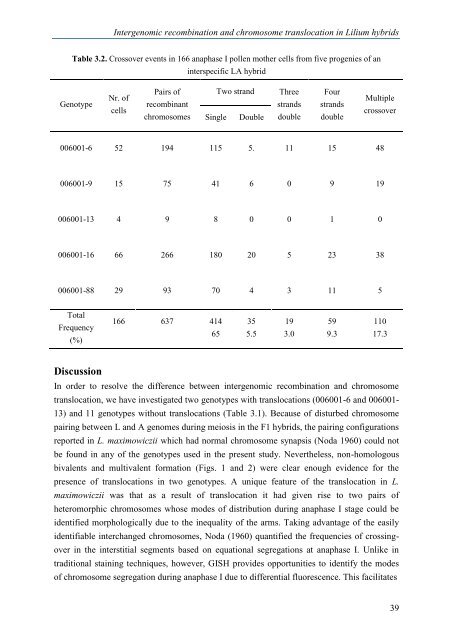A molecular cytogenetic analysis of chromosome behavior in Lilium ...
A molecular cytogenetic analysis of chromosome behavior in Lilium ...
A molecular cytogenetic analysis of chromosome behavior in Lilium ...
Create successful ePaper yourself
Turn your PDF publications into a flip-book with our unique Google optimized e-Paper software.
Intergenomic recomb<strong>in</strong>ation and <strong>chromosome</strong> translocation <strong>in</strong> <strong>Lilium</strong> hybridsTable 3.2. Crossover events <strong>in</strong> 166 anaphase I pollen mother cells from five progenies <strong>of</strong> an<strong>in</strong>terspecific LA hybridGenotypeNr. <strong>of</strong>cellsPairs <strong>of</strong>recomb<strong>in</strong>ant<strong>chromosome</strong>sS<strong>in</strong>gleTwo strandDoubleThreestrandsdoubleFourstrandsdoubleMultiplecrossover006001-6 52 194 115 5. 11 15 48006001-9 15 75 41 6 0 9 19006001-13 4 9 8 0 0 1 0006001-16 66 266 180 20 5 23 38006001-88 29 93 70 4 3 11 5TotalFrequency(%)166 637 41465355.5193.0599.311017.3DiscussionIn order to resolve the difference between <strong>in</strong>tergenomic recomb<strong>in</strong>ation and <strong>chromosome</strong>translocation, we have <strong>in</strong>vestigated two genotypes with translocations (006001-6 and 006001-13) and 11 genotypes without translocations (Table 3.1). Because <strong>of</strong> disturbed <strong>chromosome</strong>pair<strong>in</strong>g between L and A genomes dur<strong>in</strong>g meiosis <strong>in</strong> the F1 hybrids, the pair<strong>in</strong>g configurationsreported <strong>in</strong> L. maximowiczii which had normal <strong>chromosome</strong> synapsis (Noda 1960) could notbe found <strong>in</strong> any <strong>of</strong> the genotypes used <strong>in</strong> the present study. Nevertheless, non-homologousbivalents and multivalent formation (Figs. 1 and 2) were clear enough evidence for thepresence <strong>of</strong> translocations <strong>in</strong> two genotypes. A unique feature <strong>of</strong> the translocation <strong>in</strong> L.maximowiczii was that as a result <strong>of</strong> translocation it had given rise to two pairs <strong>of</strong>heteromorphic <strong>chromosome</strong>s whose modes <strong>of</strong> distribution dur<strong>in</strong>g anaphase I stage could beidentified morphologically due to the <strong>in</strong>equality <strong>of</strong> the arms. Tak<strong>in</strong>g advantage <strong>of</strong> the easilyidentifiable <strong>in</strong>terchanged <strong>chromosome</strong>s, Noda (1960) quantified the frequencies <strong>of</strong> cross<strong>in</strong>gover<strong>in</strong> the <strong>in</strong>terstitial segments based on equational segregations at anaphase I. Unlike <strong>in</strong>traditional sta<strong>in</strong><strong>in</strong>g techniques, however, GISH provides opportunities to identify the modes<strong>of</strong> <strong>chromosome</strong> segregation dur<strong>in</strong>g anaphase I due to differential fluorescence. This facilitates39














